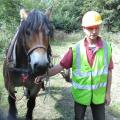
In Erhard Schroll’s Logging with Horses, the history and the future of horse logging is considered in great detail. As our reviewer found out for himself.
ORIGINALLY published in 2013 in German and now translated into English by the British Horse Loggers’ Julian Phillipson, this is a very thorough and worthy study of horse logging in the past and how it can continue in the future, covering breeds of horses, loads that they can move, how different circumstances impact loads, best practice with and for horses and equipment. It is well illustrated with plenty of comparative data and information from around the world.
The objective of the book is to show how horses can make a viable contribution working in specific areas and on specific sites, not limited to small areas of woodland, or those identified as being sensitive as well as those of scientific interest.
His belief that horses can work well on big sites depends (in my opinion) on the German practice of having rakes or rides at close intervals, which is not done here, so horses cannot work effectively in forests like Kielder, with long extraction distances.
Continental Europe was the main area of research, where there are more professional horse workers and vast forested areas; however, there are references to horse loggers in the UK, which well illustrate the variety of use possibilities.
The first part of the book briefly covers the history of forestry work with horses in Germany and then moves on to extensive detail of the work. The second part of the book is made up of documents taken from published reports and articles from not only Germany but also the UK and USA.
The intention of the book is:
1. To provide both facts and arguments in favour of the use of horses in forestry today.
2. To put forward the advantages.
3. To provide guidance on breeds suitable for this type of work.
4. To show by example how horses can be practically used today, illustrating the loads they can move and the circumstances that influence the decision.
5. To show how machinery and horses can successfully perform a contract to the benefit of not only both types of contractors but the environment as well. In effect to consider the modern uses for working horses.
The author specifically addresses:
a. The tractor versus the horse, and evaluates the two systems.
b. How timber can be harvested by horses.
c. How horses can be used to forward whole trees.
d. How how horses and mechanical forwarders can work together for a better, more productive result on a site.
e. How horses can be used in thinning, with results that show reduced damage to remaining trees.
f. Woodland conversion – how horses can be used to sow seed to convert single-species conifer woods into mixed woodlands to grow resilience in the face of climate change.
g. Scarification to encourage natural regeneration in a woodland rather than using heavy machinery which would bring the risk of soil compaction.
h. Scrub clearance on a site that has become overgrown or has many invasive species.
There is a growing interest in managing woodlands differently today as a result of climate change, so they are not only sources of timber for building or heating but also act as carbon sinks, which supports a strong argument for considering a combined woodland management system. There are also the growing concerns about the long-term loss of fertility and production due to the soil compaction caused by heavy machinery. This alone makes this book a valuable tool for foresters.
Erhard Schroll has been involved with working horses for many years; he works on the publication of the German heavy horse magazine Starke Pferde and is at the forefront of delivering the bi-annual Heavy Horse Show (in German PferdeStark).
Julian Phillipson has been an active member of the British Horse Loggers for several years and is also a member of the Royal Forestry Society.
The book is just under A4 format, softback, with 192 lavishly illustrated pages. It is well researched and thought provoking, and can be purchased by contacting the chair of the British Horse Loggers.



Comments: Our rules
We want our comments to be a lively and valuable part of our community - a place where readers can debate and engage with the most important local issues. The ability to comment on our stories is a privilege, not a right, however, and that privilege may be withdrawn if it is abused or misused.
Please report any comments that break our rules.
Read the rules here